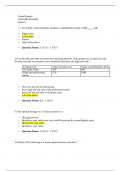-How society affects individuals’ health
-Friedrich Engels (one of the first to research society and health)
→ In England, working-class mortality rates higher
→ Children most affected by it
Whitehall Study
-Michael Marmot
-Large difference in mortality rate and diseases between class
Health inequality
-Inequality between rich countries, poor countries and rich and poor countries
Lecture 2: What is health and how do you measure it?
-WHO: Physical, mental, and social well-being not merely the absence of disease and infirmity
-Diseases can be medically defined, but illnesses is about you not feeling well (subjective)
E.g. You can have a disease without feeling ill (E.g. cancer)
How to measure health?
-Why do social scientists measure health?
→ Because it also affects many other people, not only an individual issue and everyone has the
right to live healthily
-Demographic inequality (Invisible Women)
-Life expectancy
Life expectancy
-Cohort life expectancy (CLE): an average age at mortality in a birth cohort (=people who are
born in the same year). To calculate CLE, all members of the cohort must have died
→ Takes 100 years or so (very long)
→ Use the period life expectancy (PLE): an average number of (additional) year a person is
expected to live if s/he experienced the same age-specific mortality rates of the given area and
time period for the rest of their life
-In the US, the association between SRH and the mortality rate is stronger among higher
educated people
→ They might know more about their health
Is self-rated health a valid measure of health?
→ Cross-group SRH more valid
→ Education group comparison (higher educated unhealthy people are more likely to report
their SRH lower than those with lower education)
→ In EU: Very good, good, fair, bad, very bad
→ In the US: Excellent, good, fair, poor
,Health-rated quality of life (HRQL)
, Lecture 3: Determination of population health
-Education level and mortality rate
-Wealth and mortality rate in poor countries
-Life expectancy
→ Why longer life expectancy?
→ Hygiene, sewage system, development in medicines and treatments, social policies for the
better living standard
-Nowadays, medicines are not found to be the cause of life expectancy (development of
medicine since the 1950s, 2 years + for me, 6 years + for women)
Analytical approach
-Not about statistical approach, but about how to approach RQ empirically
E.g. Comparing three cohorts of participants
Social determinants of population health (SDH)
Crucial SDH:
-SES
-Stress
-Behaviors (Smoking, drinking, eating)
→ Relating to health










